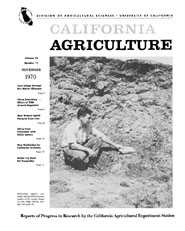


University of California
California Agriculture
|
|||
|
|||

Cover:
Retrieving sample container during Glenn County studies of dry matter losses in corn silage during storage.
November 1970
Volume 24, Number 11 |
|||
|
University of California, 1301 S. 46th St., Bldg. 478 Richmond, CA
|